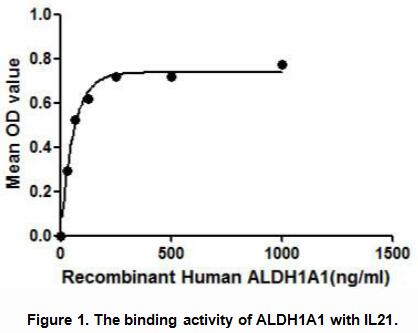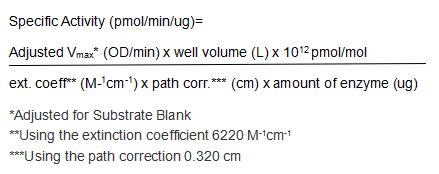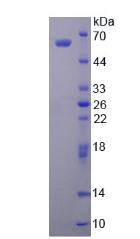Active Aldehyde Dehydrogenase 1 Family, Member A1 (ALDH1A1) 

ALDH11; ALDH1; ALDC; PUMB1; RALDH1; Retinaldehyde Dehydrogenase 1; Aldehyde dehydrogenase, cytosolic; Retinal dehydrogenase 1
- UOM
- FOB US$ 336.00 US$ 840.00 US$ 1,680.00 US$ 5,040.00 US$ 12,600.00
- Quantity
Overview
Properties
- Product No.APE824Hu01
- Organism SpeciesHomo sapiens (Human) Same name, Different species.
- ApplicationsCell culture; Activity Assays.
Research use only - DownloadInstruction Manual
- CategoryMetabolic pathway
- Buffer FormulationPBS, pH7.4, containing 0.01% SKL, 5% Trehalose.
- Traits Freeze-dried powder, Purity > 95%
- Isoelectric Point6.3
Sign into your account
Share a new citation as an author
Upload your experimental result
Review

Contact us
Please fill in the blank.
Activity test

ALDH1A1 (Retinal dehydrogenase 1) which belongs to the aldehyde dehydrogenase family, is the next enzyme after alcohol dehydrogenase in the major pathway of alcohol metabolism. ALDH1A1 converts retinaldehyde to retinoic acid. IL21 (interleukin 21) was identified as an interactor of ALDH1A1 through Affinity Capture-MS. Thus a binding ELISA assay was conducted to detect the interaction of recombinant human ALDH1A1 and recombinant human IL21. Briefly, ALDH1A1 were diluted serially in PBS, with 0.01%BSA (pH 7.4). Duplicate samples of 100uL ALDH1A1 were then transferred to IL21-coated microtiter wells and incubated for 2h at 37℃. Wells were washed with PBST and incubated for 1h with anti-ALDH1A1 pAb, then aspirated and washed 3 times. After incubation with HRP labelled secondary antibody, wells were aspirated and washed 3 times. With the addition of substrate solution, wells were incubated 15-25 minutes at 37℃. Finally, add 50µL stop solution to the wells and read at 450nm immediately. The binding activity of ALDH1A1 and IL21 was shown in Figure 1, and this effect was in a dose dependent manner.

The activity of recombinant human ALDH1A1 was also measured by its ability to produce NADH during the oxidation of propionaldehyde. The reaction was performed in 0.1 M Tris, 0.1 M KCl, 2mM DTT, pH 8.5 (assay buffer), initiated by addition 50 μL of various concentrations of ALDH1A1 (diluted by assay buffer) to 50 µL of substrate mixture 2 mM beta-NAD and 20 mM propionaldehyde. The final well serves as a negative control with no ALDH1A1, replaced with 50 μl assay buffer. Read at a wavelength of 340 nm in kinetic mode for 5 minutes. The specific activity of recombinant human ALDH1A1 is > 130 pmol/min/µg.
Usage
Reconstitute in 10mM PBS (pH7.4) to a concentration of 0.1-1.0 mg/mL. Do not vortex.
Storage
Avoid repeated freeze/thaw cycles. Store at 2-8°C for one month. Aliquot and store at -80°C for 12 months.
Stability
The thermal stability is described by the loss rate. The loss rate was determined by accelerated thermal degradation test, that is, incubate the protein at 37°C for 48h, and no obvious degradation and precipitation were observed. The loss rate is less than 5% within the expiration date under appropriate storage condition.
Increment services
-
 BCA Protein Quantification Kit
BCA Protein Quantification Kit
-
 Molecular Mass Marker for Protein
Molecular Mass Marker for Protein
-
 Monoclonal Antibody Customized Service
Monoclonal Antibody Customized Service
-
 Polyclonal Antibody Customized Service
Polyclonal Antibody Customized Service
-
 Protein Activity Test Experiment Service
Protein Activity Test Experiment Service
-
 Electrophoretic Mobility Shift Assay (EMSA) Experiment Service
Electrophoretic Mobility Shift Assay (EMSA) Experiment Service
-
 Buffer
Buffer
-
 Lentivirus Packaging Experiment Service
Lentivirus Packaging Experiment Service
-
 Adenovirus Packaging Experiment Service
Adenovirus Packaging Experiment Service
-
 Real Time PCR Experimental Service
Real Time PCR Experimental Service
-
 Spike RBD Protein (S-RBD)
Spike RBD Protein (S-RBD)
-
 Protein G
Protein G
-
 Protein A
Protein A
Citations
- Upregulation of stem cell markers ALDH1A1 and OCT4 as potential biomarkers for the early detection of cervical carcinomaDoi: 10.3892/ol.2018.9381
- High Aldehyde Dehydrogenase Levels Are Detectable in the Serum of Patients with Lung Cancer and May Be Exploited as Screening Biomarkers








